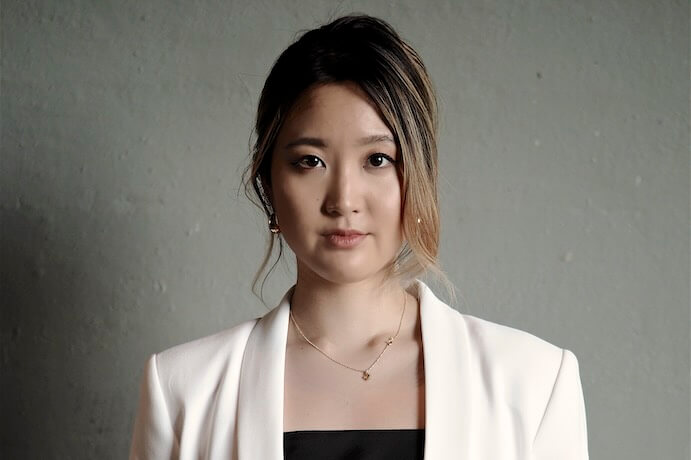Picture an electrically charged violin that buzzes and swells as it rotates inside a compressed magnetic field. Enhanced by electronics, the acoustic instrument bustles with kinetic energy, despite being confined to a narrow enclosure. [speaking in a foreign language], the debut album from Colombian-born, Philadelphia-based composer James Díaz with violinist Julia Jung Un Suh, feels like that — an experience both stimulating and stifling.
For the 10 pieces on the album, out April 19 on New Focus Recordings, Díaz employs a highly specialized toolkit equipped with reverb, frequency modulation synthesis, delays, and pitch shifting, all of which he uses to alter the sound of Suh’s violin to invariably startling effect. The composer explores the affinity and the contrasts between his electroacoustic pairing, which results in nearly fully textural music that foregrounds sound quality. The violin galvanizes the electronic processing in intriguing ways; deploying the electronics, Díaz is on equal footing with Suh as half of an electroacoustic duo, though sometimes he engulfs her violin almost entirely, stretching and distorting it to the limit.
A vortex of juxtaposed tones that swirl and spin restlessly makes up “INSIDE THE BOX,” whose coruscating texture is replete with distorted notes that sizzle and hum, falling and rising in microtonal increments. Other tones shine brighter, bristling in a supercharged atmosphere.

“they don’t see us” also builds an expansive soundscape, this time with a sci-fi-esque edge. Eerie oscillations move in slow cycles, suggesting the atmosphere of a vast exoplanet. Like in “INSIDE THE BOX,” the acoustic sound of the violin is completely swept up by the electronics here, rendered into a hazy, silvery matte.
“they became his angels” takes flight from the most conventional violin sound on the album; it starts with Suh playing near the bridge, which creates that scratchy, corrosive sound that is distinctive of contemporary composition. But Díaz processes and layers the acoustic sound with echo and tiny beeps, as the surrounding soundscape reverberates and expands.
A suddenly detuned violin pattern jolts “Fire walk with me” — the title surely a nod to auteur David Lynch. Halfway through, a harsh buzzing noise is mixed with arpeggiated violin figures and spectral tones that seem to emanate from subterranean depths, butting against the distorted violin.
Elsewhere in the album, the effects don’t deviate much from the pattern that Díaz sets early on. In “PINK ROOM,” the electronics activate a buzzing halo that develops into a feedback loop. There are quivering violin figures in “Periodo tres,” pulsating with an aggressive edge. The title track also has nervous acoustic attacks, with the electronics giving off a hum that sometimes resonates like small metallic disks; later, the violin sounds as though submerged underwater.

Other compositions benefit from a more distinct structure. In “Noche digital,” the opening melody returns after a droning contrasting section, followed by a coda that fades out slowly. And in “atardecer en 8-bits” — likely a reference to 8-bit music: synthesized “chiptunes” you hear in old videogames — a heavily distorted violin motif comes back in different guises. Suh’s vibrato-less performance is cold and stark as she etches the violin figure. In the second half, the electronic manipulation makes the instrument sound like an accordion.
Throughout, Díaz skillfully manipulates, distorts, and distends Suh’s violin. But his single-minded focus on turning the violin into an electronic instrument can also be daunting over the course of the album’s 56-minute playing time. Missing are the compositional elements that define some of the composer’s other works — the organic rushes of sound and turbulent crescendos that soar and linger, and the development of initially static textures into thorny symphonic thickets, united by a perceptible multi-part structure. You can hear a brilliant execution of that in Díaz’s psychedelic orchestral highlight Detrás de un muro de ilusiones, for example. Still, [speaking in a foreign language] succeeds in laying bare the stark contrast between the electronically processed violin and its purer, acoustic timbre, ultimately exploiting specific compositional methods to reconcile the differences.
I CARE IF YOU LISTEN is an editorially-independent program of the American Composers Forum, and is made possible thanks to generous donor and institutional support. Opinions expressed are solely those of the author and may not represent the views of ICIYL or ACF.
You can support the work of ICIYL with a tax-deductible gift to ACF. For more on ACF, visit the “At ACF” section or composersforum.org.
























